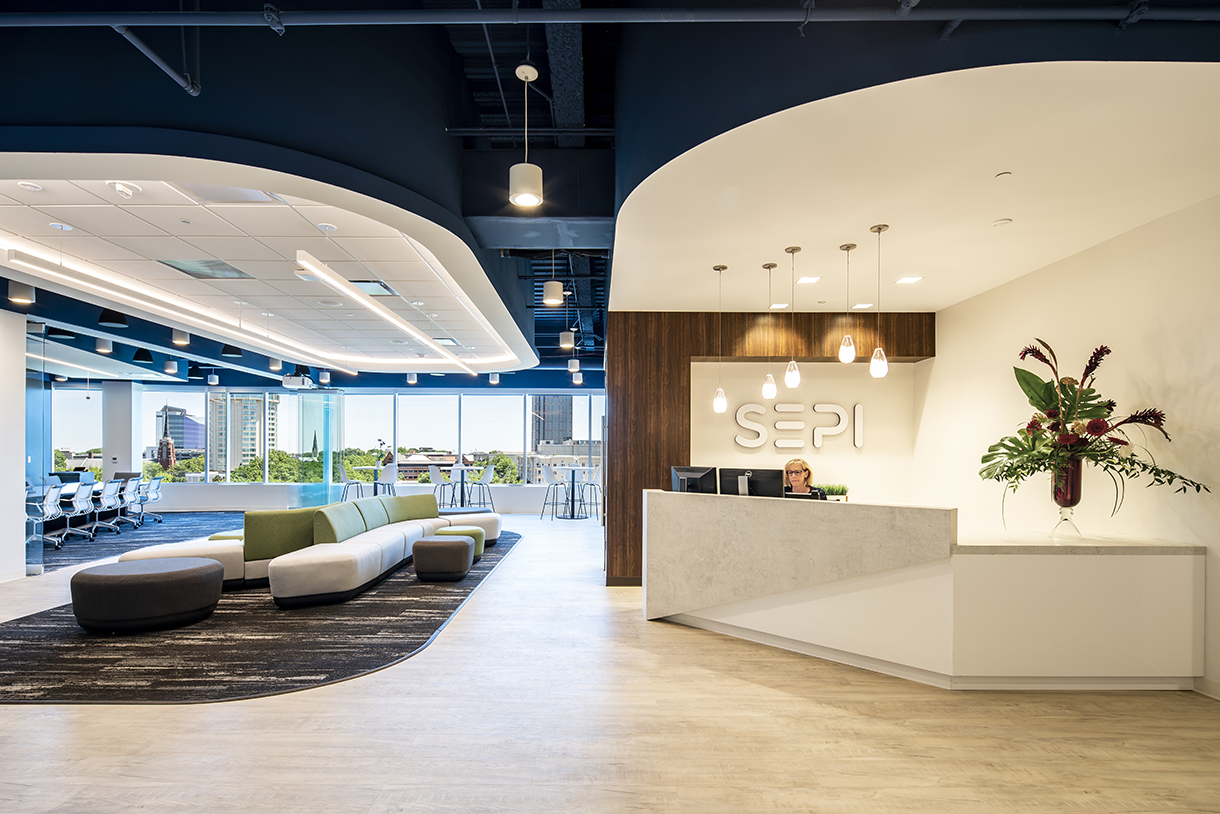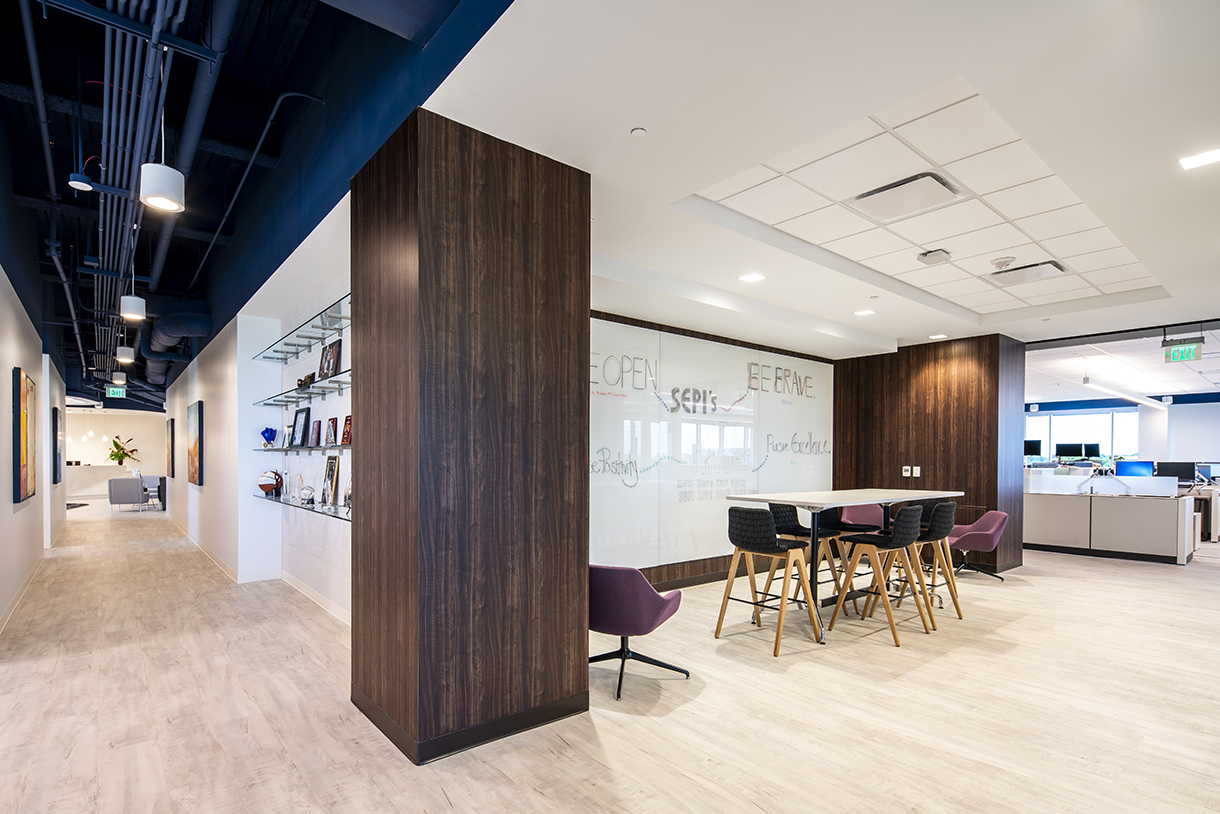Does the workplace of today reflect our societal values? Is COVID-19 helping to slow or advance the democratization of the workplace? In comparing today’s workplace to that of 50 years ago, the contrast is dramatic and telling.

The workplace was born with merchant and clerk offices that were large rooms with individual desk, much like an open office. In the industrialized society, these open office spaces could be compared to a factory floor as information and decision-making ability rested solely in the executive suite. After World War II, leaders focused on efficiency and division of labor.
Years later, middle management was introduced to compartmentalize work into manageable tasks and the capitalist ladder-climber was born. Each employee was eager to make it to the corner office with living room furniture, a private conference room, and a corner bar.

As work became more specialized and competition for knowledge-oriented expertise grew, so did the height of office partitions, creating quasi-offices as seen in the cube farms of the 1980s. The cubes functioned as miniature private offices with simple, standardized furniture solutions.
The advent of the internet in the new millennium gave all employees access to information that once flowed exclusively from the top down. Now, information flows in all directions and the social structure is amebic, flexing and adapting in organic responses to people and data. As a result of this collaborative social structure, workstation partitions were lowered, creating the modern open office. Leaders of progressive companies and firms gave up their private offices to sit with everyone else.
As a result, there has been a democratization of the workplace. Employees at all levels have equal amenities, resources, and access to leadership. The office is the physical embodiment of a company’s values. It is a branded city complete with space for individuals and the collective.

Hierarchy Breaks Down
Case in point. Over the past decade, SEPI Inc. (an engineering firm headquartered in Raleigh) had grown to occupy space in two separate buildings and other smaller locations. In redesigning their space, CEO Sepi Saidi wanted to consolidate into one space to create a collaborative and inclusive environment for staff. Originally, seven private offices were planned for the new space, but upper and middle management demanded their own offices. The original seven quickly bloomed into 48 private offices, establishing an organization hierarchy of “haves and haves not.”
After reviewing illustrated plans featuring the 48 private offices, leaders could see that the more individuals scooped up resources (daylight, views, and space requirements), the more this negatively impacted everyone else in the company. It’s simple when you think about it: The office is an ecology reduced to a finite leasable square footage.
In the end, Sepi Saidi decided that no one in the company should be allocated a private office. As a result, SEPI Inc. quadrupled the amount of collaboration space and provided daylight and views to all employees. SEPI, Inc. built a more democratic space to support and cultivate their culture and values – collaborative, inclusive, and equitable to all.

A Dramatic Difference
With COVID-19, the workplace is evolving again. There has been an increase in flexible hours, work from home, and dress-up Friday’s, because who gets dressed up for work anymore? This pandemic has brought forth social distancing requirements and work-from-home orders, dramatically shifting how we work.
This period in history is testing what democratic and equitable work and workplaces really mean. For example, some workers are “business essential” and never left the workplace during this pandemic, whereas others can work from home. Some workers can work uninterrupted at home, while others are balancing work duties along with parenting, distance learning, or caregiving. Flexibility once reserved for executives is now accessed by many, while others must increase their hours to meet essential needs.
There is also an equity issue around social structures and building networks. In the office, it’s easier to foster and grow those networks, but what if some return to work sooner than others (due to health reasons, childcare, etc.)? Will we see a different kind of social hierarchy or framework emerge? The pandemic will eventually pass, but it is worth asking: what are its long-term effects on our workplace?

There’s no Place like the Office?
As Dorothy stated in The Land of OZ, “There’s no place like home,” but after working from home for several months, employees might say, “there’s no place like the office.” Or maybe, they might just prefer to stay at home! It’s a new frontier and most companies (whether they admit it or not) are not sure exactly where things will land.
What we do know is that employers are more open to employee flexibility and accommodating working parents and caregivers. Being physically present in the office will no longer be a symbol of how much you work and your dedication to the company. With the countless software apps like Zoom, IM, and email apps, teams can collaborate remotely and create flat team organizational structures that are more equitable than before.
What does this mean for the physical workplace? Employers may offer more in-office childcare solutions. We are seeing an emphasis on diversity, equality, and inclusion in the workplace, that may manifest physically in more non-dedicated spaces for individual and shared work. The office may be treated like a gym (where you sterilize equipment before and after each use). Each company will need to revisit their values and translate them into their culture and office environment.
Now more than ever, a company’s values need to translate into physical space and form – an environment where creativity is sparked by the collective energy of the group and where everyone is mutually engaged in moving toward a shared vision and common goal. As we have seen with the COVID-19 pandemic, world events and changing priorities will shape the workplace of the future in new, unforeseen ways. Staying true to our values and creating a workplace that works for everyone – that’s our biggest challenge, and our greatest opportunity.


Great article Darian.